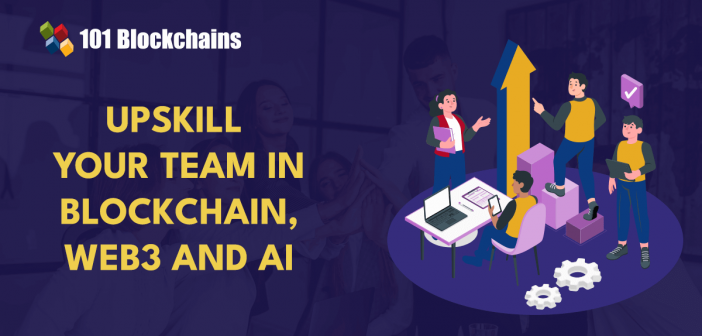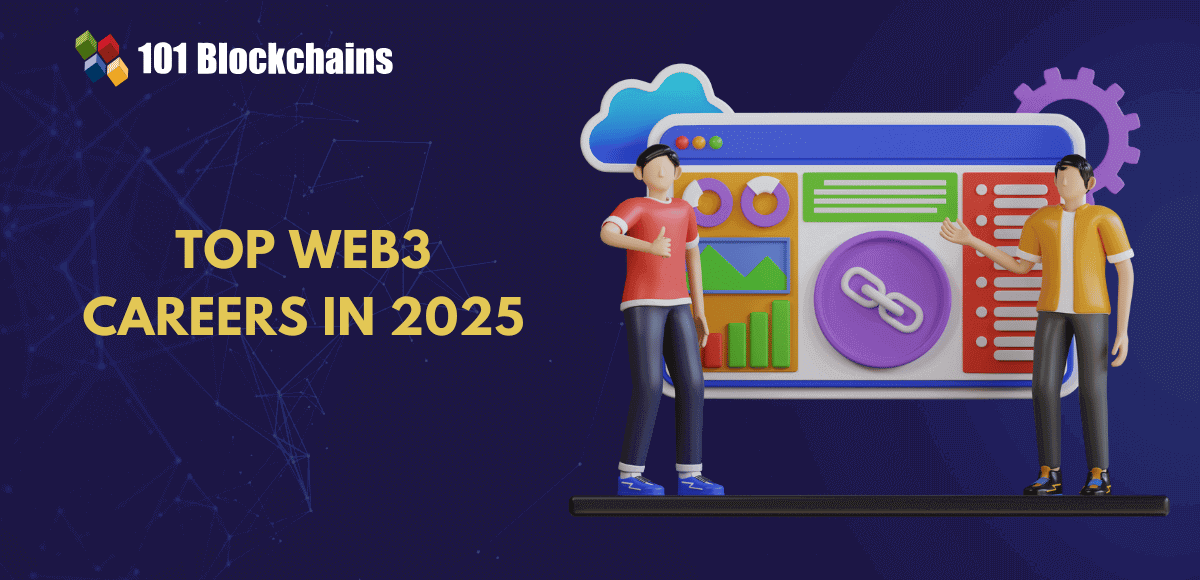Learn how blockchain truly works, master key definitions, and uncover what makes smart contracts so "smart." Dive into the fundamentals, gain valuable insights, and start your blockchain journey today!

- Career Guide
James Howell
- on November 03, 2023
Upskill Your Team in Blockchain, Web3, and AI
Skill development is an essential requirement for businesses worldwide. Every organization depends on skilled talent to address important market demands. Interestingly, new technologies such as blockchain, AI, and Web3 have registered a revolutionary impact on the existing positions. You may not find some of the existing jobs five years from now due to the power of automation and AI. At the same time, companies would come across the demand for new roles. Therefore, businesses should explore the opportunities for blockchain team upskilling and learning new skills.
Upskilling and reskilling are crucial requirements for helping businesses prepare for emerging changes. In addition, organizations could use upskilling and reskilling strategies to improve agility required to manage new advancements. Let us find out the importance of upskilling and reskilling alongside the best practices for using them.
Why Do You Need Upskilling and Reskilling?
The massive scale of changes in the existing job landscape, alongside the pace of innovation and automation in technology, have created prominent challenges for business leaders. As new technologies such as AI, blockchain, and Web3 become prominent additions to the world of business, it is more important than ever to focus on upskilling and reskilling. However, upskilling and reskilling are not about how teams learn AI or blockchain technology concepts.
Upskilling and reskilling might appear as the same term, focused on skill development. On the contrary, the two terms are crucial requirements for adapting to the emerging volatilities in the modern labor market. For example, the Great Resignation phenomenon led to more than 47 million Americans quitting their jobs in 2021.
The Great Resignation phenomenon continued, and in the eleventh consecutive month, more than 4 million people in the US resigned from their jobs in April 2022. In addition, around 83% of HR professionals have reported problems in recruiting. At this point of time, leaders have to seek the reasons behind these problems and find the ideal solutions.
Interestingly, more than half of the global workforce wants to learn Web3, blockchain, and new technologies to stay relevant in the future. Have you ever thought about the need for such skills to convince employers to reward you with better job opportunities? From the other side of the spectrum, business leaders should pay attention to the power of upskilling and reskilling for retaining talented employees.
Build your identity as a certified web3 & blockchain expert with 101 Blockchains’ Blockchain Certifications designed to provide enhanced career prospects.
What is Upskilling and Reskilling?
The reasons underlying the necessity of upskilling and reskilling point at the instabilities in the existing job market. Technologies such as blockchain, web3, AI, and machine learning have transformed the ways in which businesses used to operate. Therefore, companies would have to remove certain job roles alongside adding new roles.
At this point of time, corporate upskilling and reskilling strategies can help businesses as well as employees. Before diving further into the importance of upskilling and reskilling, it is important to know their meanings. Most of you would have assumed that upskilling and reskilling are fancy terms for skill development in an enterprise environment.
Upskilling means that you would learn a new skill or improve your existing skills for professional development. An upskilling strategy is suitable for people who want to find better chances at a promotion or career growth. For example, if you are working as a customer support executive, then upskilling initiatives for you would help you learn about managing team members, reporting customer issues to other departments, and using advanced tools. A conventional software developer could learn blockchain technology and develop the skills for creating decentralized applications or smart contracts.
On the other hand, reskilling focuses on developing new skills that are completely unrelated to the existing set of skills or job roles. Reskilling is one of the things that comes to mind when you think of “How to upskill your team?” as it focuses on learning a new set of skills. Reskilling is a recommended strategy for anyone who wants to shift their career or change to a new industry. Most important of all, it is a crucial requirement for empowering workers in sectors that face faster technological advancements. For example, a customer support executive could learn blockchain technology and coding to become a smart contract developer.
Curious to understand the complete smart contract development? Enroll Now in Smart Contracts Development Course!
Importance of Upskilling and Reskilling
The pace of innovation and change in the world right now is a miracle for every individual. Imagine how the internet changed the way we communicate with each other. While technology plays an important role in transforming our daily lives, technological advancements also transform business operations.
For example, digital technologies have helped in creating different software solutions tailored to business activities. As businesses adopt new technologies, it is important to find how to upskill employees and understand how to use the new technologies. The pace of changes in the existing digital landscape has created the demand for upskilling and reskilling to ensure success in professional as well as personal lives.
Upskilling and reskilling involve learning about new technologies alongside developing vital skills such as communication, collaboration, and teamwork. As a result, employees could achieve promising benefits for their career development. On the other hand, upskilling and reskilling could also help business leaders in achieving better efficiency and productivity from their workforce.
The World Economic Forum has reported that around 50% of employees would need reskilling by 2025. On top of it, the demand for observing upskill examples in top organizations would increase due to a lack of talent. According to the McKinsey Global Survey 2020, around 87% of business leaders report or anticipate skill gaps in their workforce.
At the same time, upskilling would emerge as a major necessity for employees to safeguard their professional careers. The World Economic Forum has stated that AI and automation will displace around 85 million jobs by 2025. Therefore, upskilling opportunities are more likely to take the limelight by helping employees prepare for disruption.
Curious to develop an in-depth understanding of web3 application architecture? Enroll Now in Web3 Application Development Course!
Do You Really Need Upskilling and Reskilling in Blockchain, AI, and Web3?
The question directly points to the significance of blockchain, web3, and AI. According to the OECD, around 1.1 billion jobs worldwide would have to go through a major transformation in the next decade. Why? The introduction of new technology would lead to introduction of new jobs or extension of skill requirements for popular job roles.
At the same time, it is important to understand why upskilling and reskilling initiatives focus on blockchain, AI, and Web3. Why would a blockchain team upskilling program serve better outcomes for employees? What would your employees gain by learning about AI or Web3? The answers to these questions can help you find why your organization needs AI and blockchain team upskilling and reskilling program.
Blockchain and Web3 are interrelated concepts that aim at creating a decentralized internet with complete control in the hands of users. You must also notice that Web3 is not just a new technological advancement. On the contrary, Web3 would change the definitions and designs of conventional business processes and systems.
Blockchain is one of the building blocks of Web3, alongside many other technologies, including AI and ML. Therefore, candidates should learn AI to prepare for job opportunities in the future. At the same time, you must also note the continuously growing volume of investments in AI and Web3 technologies. For example, the global expenditure on blockchain-based solutions will reach $19 billion by 2024.
Most important of all, big companies have been the frontrunners in adoption and experiments with new technology like AI, blockchain, and Web3. Organizations that want to go through a blockchain or web3 transformation would need comprehensive upskilling and reskilling. Preparation for new responsibilities in existing roles alongside developing and completing new skills would become the most notable priority for almost every business leader.
How Can You Build an Upskilling or Reskilling Strategy?
Upskilling and reskilling help in preparing the workforce for the future of work. Different market forces are responsible for driving upskilling and reskilling. However, corporate upskilling and reskilling initiatives focus on two noticeable factors: complexity of business operations and digital transformation. Businesses want to explore new digital strategies that could help them sustain in the uncertain market environment.
The top priorities for spending on technology include Internet of Things, Augmented Reality, Virtual Reality, AI, robotics, cloud technology, and blockchain. With digital transformation as the biggest priority of almost every business, it is important to prepare workforce for uncertainty and change.
The advantages of upskilling and reskilling could provide the motivation required to start your own program. However, it is also important to learn about the important steps required for developing an effective upskilling or reskilling initiative. Here are some of the best practices for creating your upskilling or reskilling strategy.
-
Skill Gap Analysis
The first step in answers to ‘How to upskill your team?’ for adapting to blockchain, AI, and web3 points at skill gaps. You would need a comprehensive skill gap analysis to identify important organizational requirements. Some questions can help you find the ideal way forward in the upskilling and reskilling journey. First of all, you need to find out about the position of the business amidst the emerging changes in the market. On top of that, you must have a clear impression of the long-term goals of the organization.
-
Personalized Learning Paths
The next promising step in strategies for upskilling and reskilling employees focuses on development of personalized learning paths. You should note that the primary objective of your upskilling strategy is to help employees maintain pace with the changes introduced in the industry.
Therefore, personalized learning journeys are more likely to have a better impact on the skill development of an individual. How can you create personalized learning paths for different employees in the workforce? You can find the answer with a detailed impression of the strengths and weaknesses of each employee.
-
Use Employee Feedback
What is the ideal component that can help you prepare an upskilling program for success? Employee feedback could offer the answer as it is a crucial component for designing an upskilling program. Most of the upskill examples achieve success when complemented with a culture for continuous learning in the organization.
One of the most crucial advantages of employee feedback is the opportunity to tailor the training programs according to specific requirements of employees. It could help in taking positive initiatives for the upskilling and reskilling programs while maintaining a focus on long-term objectives of the company.
-
Utilize Data-based Insights
Another crucial ingredient for improving your upskilling and reskilling programs is the use of data-based insights. How can you ensure a successful upskilling program that helps employees learn Web3 and its utilities? Collecting employee feedback and preparing upskilling and reskilling programs according to skill gaps and company goals could only scrape the surface. You need to dive deeper with the help of data analytics to identify important pointers that could help you achieve success.
-
Incorporate a Mentoring Program
One of the common misconceptions about reskilling and upskilling is that both of them are adequate for skill development of workforce. What is the use of learning new skills when you cannot use them? Therefore, it is important to find how to upskill employees while ensuring that they are prepared for the practical implications.
At this point of time, the ideal solution would point to a mentor. You can choose a mentor within the organization or someone from the outside based on your priorities and objectives. Personalized guidance to each employee in their upskilling or reskilling journey would help in extracting maximum value for your employees and the business.
Start learning Blockchain with World’s first Blockchain Career Paths with quality resources tailored by industry experts Now!
Conclusion
The reasons for upskilling and reskilling employees include the pace of innovation and change in the technological landscape. At the same time, complexity of business operations is also another reason to look for top-upskill examples and effective reskilling strategies. Upskilling focuses on preparing employees for career growth in existing job roles, while reskilling prepares employees for completely new roles.
The popularity of blockchain, web3, and AI might seem like the ideal reasons to learn about them. However, you would need blockchain team upskilling programs alongside reskilling programs for AI technology to survive in a continuously evolving market. Find the best resources to develop an effective upskilling and reskilling program for blockchain, web3, and AI right now.






